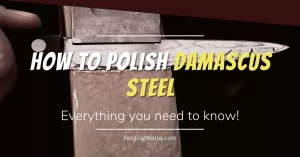Ready to forge your very own throwing axe, but feeling a bit lost when it comes to choosing the best steel? Don’t worry!
In this blog post, we’ll delve into the world of steel selection to help you pick the perfect metal for your throwing axe.
You’ll learn about the importance of durability, hardness, and other factors that play a critical role in crafting a top-notch axe.
So, let’s dive right in!
Know Your Steels: A Comprehensive Overview
Before we jump into steel selection, let’s take a closer look at the different types of steel available for forging.
In this section, we’ll break down the properties and characteristics of various steel categories, including carbon steel, stainless steel, and tool steel.
Carbon Steel: Durable and Affordable
Carbon steel is a popular choice among blacksmiths due to its durability, ease of sharpening, and relatively low cost.
The amount of carbon in the steel determines its properties, with higher carbon content generally leading to harder and more wear-resistant steel.
Some common carbon steel varieties used for throwing axes include:
1055: A medium-carbon steel with good toughness and shock resistance. It’s often used in sword and axe making due to its balance between hardness and flexibility.
1060: Slightly higher in carbon content than 1055, 1060 steel offers a good balance between hardness and toughness, making it suitable for various cutting tools, including throwing axes.
1080: A high-carbon steel that is easy to heat treat, offering excellent edge retention and durability. It’s a popular choice for knife and axe making, particularly for beginners.
1095: With the highest carbon content in this list, 1095 steel is known for its hardness and excellent edge retention. However, it can be more brittle, so proper heat treatment is crucial.
Stainless Steel: Corrosion-Resistant and Low-Maintenance
Stainless steel contains chromium, which gives it corrosion-resistant properties. While it’s not as tough as carbon steel, stainless steel is an excellent option for those seeking low-maintenance tools.
Some popular stainless steel varieties for throwing axes include:
420: A lower-end stainless steel, 420 is easy to work with but has lower wear resistance and edge retention compared to other stainless steel varieties.
440A: A mid-range stainless steel, 440A offers decent corrosion resistance, toughness, and edge retention. It’s a good choice for those looking for a balance between performance and cost.
440C: A high-end stainless steel, 440C boasts excellent hardness, wear resistance, and edge retention. However, it can be more challenging to work with and is more expensive than other stainless steel options.
Tool Steel: High-Performance and Wear-Resistant
Tool steel is a category of high-performance steel specifically designed for manufacturing tools and cutting implements.
These steels have excellent wear resistance and edge retention but can be more challenging to work with due to their hardness.
Some popular tool steel options for throwing axes are:
O1: An oil-hardening tool steel, O1 offers excellent edge retention and wear resistance. It’s relatively easy to work with and heat treat, making it a popular choice for various tools, including knives and axes.
D2: A semi-stainless tool steel, D2 is known for its exceptional wear resistance and edge retention. However, it can be challenging to heat treat and is more prone to chipping than other tool steels.
A2: An air-hardening tool steel, A2 offers a good balance between toughness, wear resistance, and edge retention. It’s easier to heat treat than D2 but may be more expensive and harder to work with than O1.
| Steel Type | Category | Pros | Cons |
|---|---|---|---|
| 1055 | Carbon Steel | Good toughness, shock resistance, easy to work with | Lower hardness, edge retention, rusts easily |
| 1060 | Carbon Steel | Good balance of hardness and toughness, easy to work with | Rusts easily |
| 1080 | Carbon Steel | Easy to heat treat, excellent edge retention, durability | Rusts easily |
| 1095 | Carbon Steel | High hardness, excellent edge retention | More brittle, rusts easily, requires proper heat treatment |
| 420 | Stainless Steel | Easy to work with, corrosion-resistant | Lower wear resistance, edge retention |
| 440A | Stainless Steel | Decent corrosion resistance, toughness, and edge retention | Moderate ease of workability, medium cost |
| 440C | Stainless Steel | Excellent hardness, wear resistance, edge retention, corrosion-resistant | More difficult to work with, expensive |
| O1 | Tool Steel | Excellent edge retention, wear resistance, moderate ease of workability | Medium corrosion resistance, medium cost |
| D2 | Tool Steel | Exceptional wear resistance, edge retention | Difficult to heat treat, prone to chipping, more expensive |
| A2 | Tool Steel | Good balance of toughness, wear resistance, and edge retention | More difficult to work with, expensive |
Durability Matters: Choose a Steel That Can Take a Beating
When it comes to choosing the best steel for your throwing axe, durability should be a top priority.
Throwing axes endure a lot of abuse, so you’ll want a steel that can withstand repeated impacts without chipping or breaking.
Carbon steel, particularly high-carbon varieties like 1095, is an excellent choice due to its toughness and ability to hold a sharp edge.
Check out our guide on the best knife-making steel for beginners for more information on various steel types.
Hardness vs. Toughness: Striking the Right Balance
It’s essential to understand the balance between hardness and toughness when selecting a steel for your throwing axe.
Hardness refers to a material’s ability to resist deformation, while toughness is its ability to absorb energy without breaking.
Generally, harder steels hold a sharp edge better but are more brittle, whereas tougher steels can withstand more impact but may not hold an edge as well.
Carbon steel, especially in the 1055-1095 range, offers a good balance between hardness and toughness, making it a popular choice for throwing axes.
To learn more about forging your own throwing axe, visit our step-by-step tutorial on how to forge a throwing axe.
Consider the Tools and Techniques You’ll Be Using
The steel you choose for your throwing axe should also depend on your blacksmithing tools and techniques.
Some steels may require specialized equipment or more advanced forging techniques. If you’re just starting, consider selecting a more beginner-friendly steel like 1080 carbon steel or 440C stainless steel.
For more information on the tools required to forge a throwing axe, take a look at our list of essential tools for forging a throwing axe.
Don’t Forget the Heat Treatment
Heat treatment is a critical step in the forging process that can significantly impact your throwing axe’s performance.
Different steels require specific heat treatments, so make sure to research the best heat treatment methods for your chosen steel.
Proper heat treatment can greatly enhance the durability, hardness, and edge retention of your throwing axe, ensuring it performs at its best.
Our guide on quenching liquids for blacksmiths and knife makers provides a great overview of various quenching methods suitable for different steel types.
Budget and Availability
Last but not least, consider your budget and the availability of the steel you’re interested in using. High-quality steel can be pricey, but it’s essential not to skimp on quality.
Research the cost of different steel types and find a balance between price and performance that suits your needs.
Keep in mind that some types of steel may be more challenging to source, so factor in the time and effort required to find the right materials.
If you’re on a tight budget, consider using reclaimed materials like leaf springs, which can be an excellent and affordable option for forging.
Check out our article on the pros and cons of using leaf spring steel for knife making to learn more.
Frequently Asked Questions
Key factors to consider include hardness, toughness, wear resistance, edge retention, corrosion resistance, ease of workability, and cost.
Both carbon steel and stainless steel have their advantages. Carbon steel is known for its durability and ease of sharpening, while stainless steel offers corrosion resistance and low maintenance. Your choice depends on your preferences and intended use for the axe.
Carbon steel is a durable, affordable option that’s easy to work with but prone to rust. Stainless steel is more corrosion-resistant, but may not be as tough as carbon steel. Tool steel offers exceptional wear resistance and edge retention but can be more challenging to work with.
Yes, you can forge a throwing axe from scrap metal, but the quality of the finished product will depend on the metal’s properties and your forging skills. Proper heat treatment and forging techniques are essential for a high-quality axe.
Heat treatment is crucial for achieving the desired balance of hardness and toughness in your throwing axe. It helps improve edge retention, durability, and overall performance.
Proper maintenance includes regular cleaning, sharpening, oiling (for carbon steel axes), and storing in a dry place to prevent corrosion. Also, inspect your axe regularly for any signs of damage or wear.
Common mistakes include using the wrong type of steel, improper heat treatment, uneven forging, and not paying attention to the axe’s balance and weight distribution.
Final Thoughts
Choosing the best steel for your throwing axe is a crucial step in crafting a high-performing and durable tool.
Keep in mind factors like durability, hardness, toughness, your forging tools and techniques, proper heat treatment, and budget when selecting the right steel for your project. By doing so, you’ll be well on your way to forging an impressive throwing axe that you can be proud of.
For more tips, advice, and in-depth guides on all things blacksmithing, don’t forget to visit our website, Forging World, where you’ll find a treasure trove of knowledge to fuel your forging journey.
Good luck, and happy forging!


